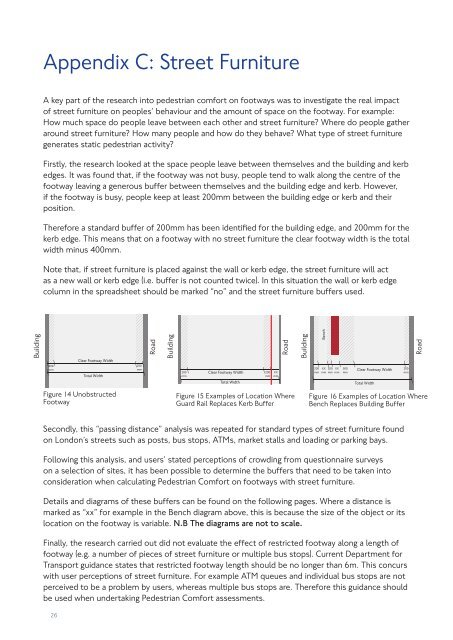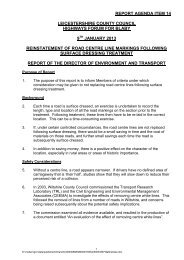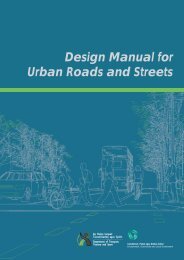Pedestrian Comfort Guidance for London
Pedestrian Comfort Guidance for London
Pedestrian Comfort Guidance for London
Create successful ePaper yourself
Turn your PDF publications into a flip-book with our unique Google optimized e-Paper software.
Building<br />
Appendix C: Street Furniture<br />
A key part of the research into pedestrian com<strong>for</strong>t on footways was to investigate the real impact<br />
of street furniture on peoples’ behaviour and the amount of space on the footway. For example:<br />
How much space do people leave between each other and street furniture? Where do people gather<br />
around street furniture? How many people and how do they behave? What type of street furniture<br />
generates static pedestrian activity?<br />
Firstly, the research looked at the space people leave between themselves and the building and kerb<br />
edges. It was found that, if the footway was not busy, people tend to walk along the centre of the<br />
footway leaving a generous buffer between themselves and the building edge and kerb. However,<br />
if the footway is busy, people keep at least 200mm between the building edge or kerb and their<br />
position.<br />
There<strong>for</strong>e a standard buffer of 200mm has been identified <strong>for</strong> the building edge, and 200mm <strong>for</strong> the<br />
kerb edge. This means that on a footway with no street furniture the clear footway width is the total<br />
width minus 400mm.<br />
Note that, if street furniture is placed against the wall or kerb edge, the street furniture will act<br />
as a new wall or kerb edge (i.e. buffer is not counted twice). In this situation the wall or kerb edge<br />
column in the spreadsheet should be marked “no” and the street furniture buffers used.<br />
200<br />
mm<br />
Clear Footway Width<br />
Total Width<br />
Figure 14 Unobstructed<br />
Footway<br />
200<br />
mm<br />
Road<br />
Building<br />
200<br />
mm<br />
Clear Footway Width 200<br />
mm<br />
Total Width<br />
Figure 15 Examples of Location Where<br />
Guard Rail Replaces Kerb Buffer<br />
Figure 16 Examples of Location Where<br />
Bench Replaces Building Buffer<br />
Secondly, this “passing distance” analysis was repeated <strong>for</strong> standard types of street furniture found<br />
on <strong>London</strong>’s streets such as posts, bus stops, ATMs, market stalls and loading or parking bays.<br />
Following this analysis, and users’ stated perceptions of crowding from questionnaire surveys<br />
on a selection of sites, it has been possible to determine the buffers that need to be taken into<br />
consideration when calculating <strong>Pedestrian</strong> <strong>Com<strong>for</strong>t</strong> on footways with street furniture.<br />
Details and diagrams of these buffers can be found on the following pages. Where a distance is<br />
marked as “xx” <strong>for</strong> example in the Bench diagram above, this is because the size of the object or its<br />
location on the footway is variable. N.B The diagrams are not to scale.<br />
Finally, the research carried out did not evaluate the effect of restricted footway along a length of<br />
footway (e.g. a number of pieces of street furniture or multiple bus stops). Current Department <strong>for</strong><br />
Transport guidance states that restricted footway length should be no longer than 6m. This concurs<br />
with user perceptions of street furniture. For example ATM queues and individual bus stops are not<br />
perceived to be a problem by users, whereas multiple bus stops are. There<strong>for</strong>e this guidance should<br />
be used when undertaking <strong>Pedestrian</strong> <strong>Com<strong>for</strong>t</strong> assessments.<br />
26<br />
XX<br />
mm<br />
Road<br />
Building<br />
Bench<br />
200 XX 200 XX<br />
mm mm mm mm<br />
500<br />
mm<br />
Clear Footway Width<br />
Total Width<br />
200<br />
mm<br />
Road




